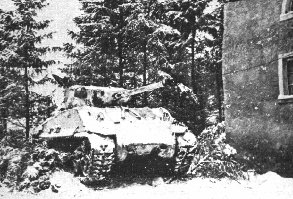
 Each member of the 6th Armored Division has ample reason to thrill with
pride for what he and his comrades have accomplished in more than six months
of uninterrupted combat. The following pages give but a meager picture
of the gallantry and the sacrifices that mean so much to each individual.
The story as told here, briefly describes how brave and resolute men, organized
to fight as a tram, inspired by the heroic action of many of their fellows
marched and fought from one success to another through the whole of Northern
France from Normandy to the tip of Brittany, to the eastern borders of
Luxembourg. I dedicate these pages to the memory of our comrades whose
spirit will forever urge us on to win Peace.
Each member of the 6th Armored Division has ample reason to thrill with
pride for what he and his comrades have accomplished in more than six months
of uninterrupted combat. The following pages give but a meager picture
of the gallantry and the sacrifices that mean so much to each individual.
The story as told here, briefly describes how brave and resolute men, organized
to fight as a tram, inspired by the heroic action of many of their fellows
marched and fought from one success to another through the whole of Northern
France from Normandy to the tip of Brittany, to the eastern borders of
Luxembourg. I dedicate these pages to the memory of our comrades whose
spirit will forever urge us on to win Peace.
Major General, Commanding

Bloody Bastogne -- 30 days of freezing hell!
This was the end of the first six months of combat for the 6th Armd. Div. Withdrawn from the Saar River area Dec. 24, 1944, and put in Corps reserve, the men under Maj. Gen. Robert M. Grow were rushed to the Third Army front on the south of the Ardennes salient, relieving the 10th Armd. Div. north of Mersch, Luxembourg.
Five days later, Super Sixth was shifted to positions northeast of the now-famous city. The pocket in which the 101st Airborne and armored units had made such a gallant stand had become a bulge. Facing that bulge was one of the greatest enemy concentrations since the Ardennes Forest offensive began.
Still trying desperately to capture Bastogne, the Germans threw everything in the book at the 6th -- tanks, infantry, artillery, rockets, bombs. For 23 snowbound, freezing days, 6th and Nazis fought a see-saw battle. Yanks took towns, lost them to numerically superior forces, later recaptured them.
Slowly, the Germans relinquished their grip on the east shoulder of the bulge. Waging strong rear-guard action, they completed their 20-mile withdrawal across the Our River into Germany and the Siegfried Line by Jan. 26, 1945.
For the enemy, Bastogne marks the stumbling block in its Ardennes offensive. For the 6th Armd. Div., Bastogne, where it faced the most formidable force of SS and Wehrmacht troops since going operational, stands as the supreme test. Primed for the thrust, Hitler's troops were the elite of his army, possessing the best equipment, vehicles and supplies. The 6th was greatly outnumbered by elements of six enemy divisions which constantly applied pressure against its entire front.

Bastogne brought a new experience. Snow, ice and sub-freezing weather provided the setting for one of the most severe campaigns ever fought by American troops. Tank turrets froze, had to be chipped free to regain traversing action. Iced breach blocks had to be manually operated. M-1s refused to function until bolts were beaten back and forth with grenades. When escape hatches and tank doors stuck fast, they got "blow torch" treatment. Ice formed in gas tanks and clogged lines. Feet froze. Men became so cold they "burned."
That was Bastogne!
When the Super Sixth hit the front Dec. 29, the 101st Airborne was on the left, the 35th Div. on the right flank. Entering the campaign along a line two miles northeast of Bastogne, CC A jumped off Dec. 31. A task force under Maj. Chester E. Kennedy, Detroit, took the high ground near Wardin, assisted by Task Force Brown on the right. Further gains were made the next three days against mounting resistance. Neffe and Bizery fell to CC A while a task force under Lt. Col. A.R. Wall, Denver, captured Mageret, went on to enter Michamps. Other forces commanded by Lt. CoI. Embry D. LaGrew, Lexington, Ky., and Lt. Col. Frank K. Britton, Hartford, Conn., entered Wardin and took high ground to the south.
But their 12,000 yard front proved too much to hold with only three infantry battalions, and lines were shortened to 8000 yards. Then came the Germans' inning. While withdrawing at dusk Jan. 4, task forces under Col. Britton and Lt. Col. Charles E. Brown, Tacoma, Wash., were struck by artillery, tanks and infantry. Although temporarily cut off, some units withdrew to a new position, organized and repulsed the attack. Troops under Col. Wall and Lt. Col. H. C. Davall, Washington, D.C., stopped counter-attacks in CC B's sector with infantry, tanks, TDs and well-directed artillery.
Germans held the upper hand for five days, directing tank-infantry teams against the entire front. The tide shifted Jan. 9 when the 6th began to surge forward reinforced by the 320th Regt., 35th Inf. Div.
It was a grueling ordeal. Nine long, bitter-cold days were used to push back the enemy four miles, taking the ground astride the Longvilly-Bourcy highway and the by-now familiar towns of Wardin, Mageret, Benonchamps, Arloncourt, Oubourcy, Longvilly and Michamps.
Germans pulled back from the western-most tip of the salient, and the 6th ploughed forward. Troine, Cranial, Lulling, Hoffelt and Hachiville fell quickly to tank- infantry teams making five-mile dashes through heavy snow. Strong rear-guard action was encountered, but Asselborn, Weiler, Basbellain. Biwisch and Troisvierges were retaken in two days. The enemy's Ardennes salient was wiped out completely during the next three days. Wilwerdange, Briedfeld and the high ground astride the Skyline Drive were captured.
By Jan. 26, with losses of 2298 prisoners, 87 tanks, 33 big guns, 17 vehicles and one JU-88, had withdrawn across the Our River, more than 20 miles from Bastogne.

When the last units of the untried 6th Armd. Div. arrived at Les Mesnil, Normandy, July 24, 1944, orders for embarkation from England to Omaha Beach were but 10 days old.
Two weeks later, the Super Sixth pulled up at the gates of Brest, creating complete disorganization enroute and bottling up 40,000 Germans for eventual capture.
How the division, operating in vitally important territory defended bv 80,000 Nazis (about six times the division's strength) made the 250-mile drive in 10 days is a masterpiece of armored operations.
Confident but never cocky, each member of the division always felt the Super Sixth was destined for greatness. The 6th had received the best unit and maneuver training AGF could dish out at Camp Chaffee, Ark., in Louisiana, the California desert and at Camp Cooke, Calif. After arriving in the United Kingdom, the division sharpened up for the big show with five months of dress rehearsal.
This potent feeling was amplified further on the eve of the 6th's jump-off through Lessay when Gen. Grow said:
I don't care if we do get so far out in front we are completely surrounded. We've enough fire-power and mobility to punch out of anything the Krauts have to offer.
The Division maintained that spirit from the moment it passed through the 79th Div. at Lessay, cleared Brehal and Granville, shot through Avranches, swung west toward Brest, cut a 20 mile swath 200 miles into the heart of the Brittany Peninsula.
The 50-mile end run down the Normandy coast to the mouth of Brittany and the drive on to Brest paid tribute to the soundness of training and tactical principles. It demonstrated to infantrymen that their rugged operations in establishing beachheads and setting the stage for the breakthrough were not in vain.
The entire campaign was a series of engagements made to order for effective armored operations. Dashing into enemy territory without infantry support for mopping-up purposes, the division found its zone allowed sufficient latitude for by-passing, enveloping, feinting and cutting Nazi communication lines, despite numerically superior enemy forces.
Speed of its advance permitted the division to fight on ground of its own choosing. Bold marches and bypassing enemy strong points kept losses of men and equipment to a minimum. Because of the rapid advance, the enemy could not establish a solid defense line. Through a country laced with rivers, the Germans had time to destroy only two bridges, each involving no more than a 12-hour delay. Outflanking the enemy brushed aside his resistance.
Tactics permitted racing columns to average 25 miles a day. The greatest distance -- 48 miles -- was swallowed on Aug. 3. The division captured 4556 prisoner while suffering only five percent casualties. An estimated 4000 enemy were killed, and 1,000 guns, combat and other vehicles were knocked out or abandoned during the period. Top PW prize was Lt. Gen. Karl Spang, Commander of the 266th German Inf. Div.
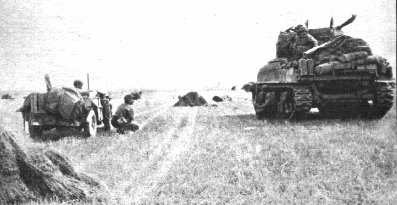
When Troop A of the 86th Cav. Recon. Sqdn., commanded by Capt. Frederick H. Eickhoff, St. Louis, moved out at 1630, July 27, to contact the enemy it became the first Super Sixth unit to be committed. The division moved out in force the next day when CC A, under Brig. Gen. James Taylor, crossed the Ay River at Lessay, passed through the 79th Div, and became the spearheading force.
CC B was commanded by Col. George W. Read, Santa Barbara, Calif., Reserve Command by Col. Harry F. Hanson, Elgin Ill. In support was Division Artillery under Lt. Col. William J. Jesse, Mexico, Mo. Other separate commands were the 86th Recon, under Col. Albert E. Harris, Reno, Nev.; and Division Trains commanded by Col. Elmer H. Droste, Mt. Olive, Ill.
Jump-off day found Super Sixth under Maj. Gen. Troy H. Middleton's VIII Corps, then a unit of First Army. Operations with First Army were short but sweet. With CC A and B alternating as spearheading forces, the division was quick to catch the competitive spirit. During the first four days it advanced 58 miles flushed out 841 prisoners, captured key Normandy points of Pont de la Roche, Brehal and Granville. A treadway bridge was constructed over the Seine River by the 25th Armd. Engrs. near Pont de la Roche, July 29 and 30.
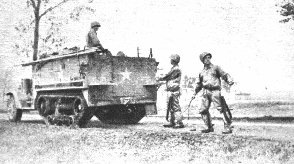
The Nazis, cornered in the Avranches area by the 4th and 6th Armd. Divs., lacked gas. Their horse drawn vehicles were cut to ribbons by tank and artillery fire and fighter planes.
On Aug. 1, when Lt. Gen. George S. Patton, Jr., commander of Third Army, was disclosed as being on the warpath in the ETO, VIII Corps and the 6th Armd. Div., among other units, came under his command.
This change brought together Generals Patton and Grow for the first time since they were members of the 2nd Armd. Div. at Ft. Benning, Ga. Then, Gen. Patton was Division Commander of the "Hell-on-Wheels" outfit, while Gen. Grow was Asst. Chief of Staff, G-3.
Task Force Hanson moved out July 31 to enter the mouth of the peninsula and secure bridges northwest of Avranches and at Pontaubault. Next day, elements of the division ran into their first real engagement when Task Force Hanson encountered a roadside ambush near Bree where Germans were ready with 88s, mortars, bazookas and small arms. Initial fire was directed at Btry. A, 231st FA, the last unit in the advance guard.
Despite this surprise attack, the advance guard pushed ahead 28 miles to complete the mission -- forcing a bridgehead across the Couesnon River at Pontorson. Attacked while passing through a narrow defile, three M-7 105 mm, self-propelled artillery pieces were knocked out. Other units of the task force went into action and gained the upper hand after sharp action.
That action made veterans. Topping the list was "One-Man Army" Sgt. John L. Morton, Btry. A, 231St FA. When the enemy put three of his M-7s out of action that didn't daunt this Boonville, Mo., GI. He bagged 16 Germans with a carbine before his ammunition ran out. Then he picked up a sub-machine gun and dropped three more trying to escape on a truck. He received the division's first Distinguished Service Cross.
Courage and initiative displayed against enemy fire was outstanding up and down the line. Many tankers, including S/Sgt. Vernard T. Brock-Jones, 68th Tank Bn., Westfield, Ill.; Sgt. Paschal S. Mathison, 69th Tank Bn.; New Rochelle, N.Y, both battlefield lieutenants now; and S/Sgt. Peter Turko, 15th Tank Bn., New Hyde Park, N.Y., demonstrated their coolness and gallantry, received Silver Stars.
Armored infantrymen like Pvt. Jack Phillips, 9th Bn., Heflin, Ala.; M/Sgt. Albert Blumberg, 44th Bn., Philadelphia; and T/5 Thomas R. Sills, a medic with the 50th Bn., from Model, Tenn., also covered themselves with glory. T/Sgt. John H. Watson, 128th Ord., Pittsburgh, a volunteer ammunition trucker, showed fortitude when he drove much-needed ammunition to tankers through enemy fire.
In the Avranches bottleneck, Super Sixth men got their first glimpse of the Luftwaffe -- many with a foxhole perspective. For several days, German airmen strafed 6th Armd. columns and bombed bridges that had been captured too swiftly for demolition crews to destroy. But the division passed into Brittany with negligible losses.
Light casualties were attributed to excellent marksmanship of the 777th AAA Bn., commanded by Lt. Col. Joseph H. Twyman, San Pedro, Calif. During a 40-hour period enemy planes were particularly active. The 777th, engaging in its first combat, knocked down 18 of 44 planes to establish a percentage record for Third Army AAA outfits.
Carrying precious gasoline, ammunition and food, Division Trains, the last unit to pass through the only available highway into Brittany at Avranches, found the triple 7s exceptionally lucky numbers to have around. German bombers made an all-out effort on the moon-bathed night of Aug. 1 to bomb a critical bridge. At the peak of the assault, with 500-pounders striking within 200 yards of the objective, Trains units successfully ran the gauntlet of the attack.

Aug. 2 marked the first time the division engaged the enemy entrenched in fortified positions. CC B hit the foe in force east of Dinan, which constituted part of the St. Malo defensive works manned by 20,000 Germans. To reduce the fortress would cause several days' delay, so CC B was ordered to break contact and sideslip the town. Despite the active day, the division suffered light casualties, advanced 26 miles, captured 150 prisoners, left the strong Dinan defenders feeling as ignored as a boxer with no opponent but his shadow.
"These maps are too small. Give me a map large enough so that I won't run off it today." Gen. Grow's statement was prompted by the speed of the advance which had put maps on the critical supplies list. Columns raced across sections of maps almost before navigators could fix them to boards.
"You're doing pretty good, Bob!" Gen. Patton told Gen. Grow at the division CP near Merdrignac, Aug, 4. With the sun blazing down on the dusty bivouac area, Gen. Patton then presented him with a Bronze Star for meritorious achievement, the first battlefield decoration received by Super Sixth.
The Division Commander learned definitely that the 6th was to make the run for Brest without any direct infantry support. The 4th Armd. Div. was on the left (southern) flank with the mission of taking Lorient and Rennes. Gen. Grow realized the Germans in that sector were a ragged, disorganized army with disrupted communications. To give them any quarter was to invite them to dig in on the 6th's march into Brittany.
CC A and Reserve Command hacked away at Huelgoat, the next enemy strong point. Reserve Command ran into enemy forces at Huelgoat. CC A captured the town after sharp encounters. The enemy withdrew to the Morlaix defenses.
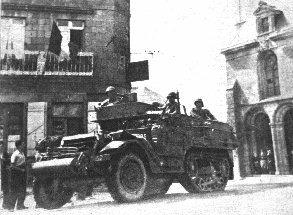
The first posthumous DSC was earned by 2nd Lt. James L. Durden, Mt. Vernon, Ga., reconnaissance platoon leader with the 15th Tank Bn. in the Huelgoat action. Lt. Durden was greatly responsible for the success of the attack when he went forward on foot to clear a mine field and direct tank drivers along a safe path.
During this same two day period, the division advanced 47 miles, killed or wounded an undetermined number of the enemy, destroyed seven big guns and three vehicles.
The ninth and tenth days saw Super Sixth advance 80 miles, draw up before the outskirts of Brest, after Lesneven, Plouvien and Bourg Blanc were cleared. CC B encountered considerable artillery, mortar and machine gun fire just south of Bourg Blanc until a large OP and AA warning system were destroyed.
That final day's operation set the stage for a concerted attack on the Nazi stronghold.
But first, on Aug. 8, Gen. Grow issued an ultimatum to the German Commander of Brest. Delivered by Lt. Col. Ernest W. Mitchell, Arlington, Mass., and M/Sgt. Alex Castle, New York City, an interpreter, the ultimatum read:
1. The United States Army, Naval and Air Forces troops are in a position to destroy the garrison of Brest.
2. This memorandum constitutes an opportunity for you to surrender in the face of these overwhelming forces to representatives of the United States government and avoid the unnecessary sacrifice of lives.
3. I shall be very glad to receive your formal surrender and make the detailed arrangements any time prior to 1500 this date. The officer who brings this memorandum will be glad to guide you and necessary members of your staff, not exceeding six, to my headquarters.
But history already has recorded how the Germans rejected the ultimatum, blew the docks sky-high and caused the city to be shattered by Allied ground, air, and naval forces before surrendering to VIII Corps.

The planned attack on Brest momentarily was postponed. Artillery from the fortress pounded elements of CC A while the 266th German Div., attempting to break into the city, struck the division's rear. The 6th executed an about-face and attacked.
The 266th ran head-on into the 86th Recon as well as other covering units as it threatened to over-run the PW enclosure (with General Spang as the choice prize) and Div. Hq. The Germans completely surrounded the division. Towering hedgerows prevented identification of friendly or enemy forces. Small arms fire spattered over the bivouacs.
But the battle was really one-sided. CC B, smacking the center, soon made the Germans lose interest in finding an avenue of escape into Brest. When smoke of the eight hour battle lifted, the scoreboard read: 230 Germans killed, 70 wounded, 800 captured. More than 200 vehicles and 20 anti-tank guns were captured or destroyed.
Plouvien, which was to be known as the "massacred" town of Brittany, had to be retaken by CCA. The Germans reentered the town after the 6th passed through and blazed fire down streets and into homes, killing many civilians. Planes supported CC A tanks and infantry in ridding the town of the German plague for the last time.
Reserve Command sharpened its sights on the left flank. Encountering a heavy weapons company, doughs of the 50th Inf. killed 19, captured 47, destroyed one 88 mm, six mortars, four machine guns, several vehicles.
Contributing to the success of combat troops was Trains Command, truck companies, medics and ordnance personnel who performed their duties in superior style. At no time during the long and arduous fighting march did any unit find itself unable to move for lack of supplies, equipment or maintenance. Trains units assumed a definite combat complexion by taking more than 1000 prisoners.
Some runs made by supply trains totaled 400 miles round trip, many times through towns and country reoccupied by Germans. Tank and other combat units protected the long line of communications and local installations.
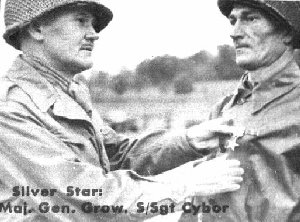
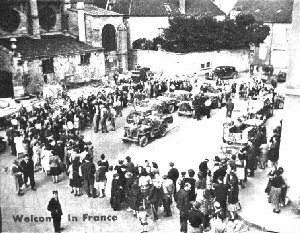
Unofficial home page of the
6th Armored Division Association.
LINKS
Next section.